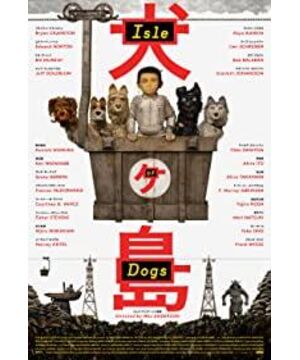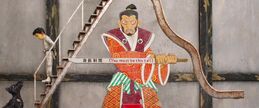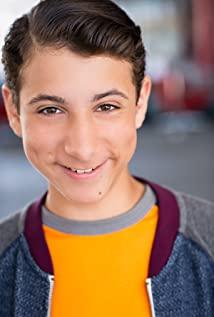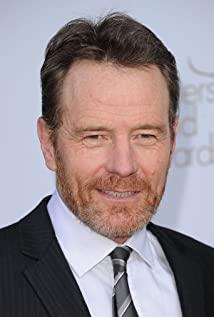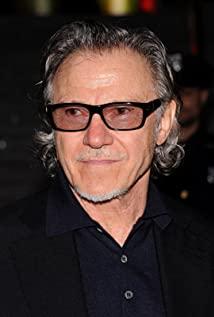This article was published on the DeepFocus public account on April 30, 2018
This article is translated from an exclusive interview with "Sight and Sound"
Translation | Tianyi, MYZ
Starring a pack of dogs and a script almost half written in Japanese, Wes Anderson's new film paints a vision of a future Fantasy. Here, Anderson and his three writing partners are here to chat with us about the creative process of "Isle of Dogs."
If you're curious, I can tell you that Wes Anderson's new film, Isle of Dogs, is not a story set on the East London Pier peninsula, which does sound a bit unusual, but yes it's a puppet story about the future A stop-motion animation of Japanese stories. Mayor Kobayashi used his power to spread Snout Fever and dog flu in Megasaki City. Despite the efforts of many canine scientists to find the serum, Mayor Kobayashi has exiled all the dogs to the trash island. Spots were the first to be exiled, but in just six months, several vicious gangs have emerged on the island, and they are not just a pack of alpha dogs. And the adventure really begins when Atali, the mayor's adopted son, makes a forced landing on the island and joins the gang of "lead dogs"—"Boss," "King," "Monarch," "Duke," "Chief"— Find Spots together.
Anderson's second animated film after The Great Fox (2009) is more ambitious and more discreet. The director has made nine films so far - "Bottle Rocket (1996)", "Youth (1998)", "Genius (2001)", "Water Life (2004)", "Crossing Darjeeling (2007)" )", "Fantastic Daddy Fox", "Moonrise Kingdom (2012)", "The Grand Budapest Hotel (2014)" and this new film—established a distinctive style and visual style that is instantly recognizable . It even inspired an Instagram account called "Accidental Wes Anderson", through which people posted "Anderson-style" pictures they captured in their everyday lives that looked like A screenshot belonging to one of his movies.
The following interview was conducted by myself, the host, and the writing team of "Isle of Dogs" - Wes Anderson, Jason Schwartzman and Roman Coppola. This took place at the "Art Society [y3]" not far from the Brandenburg Gate after the film's media premiere at the Berlin Film Festival, and, as in this film, there was an uplifting moment before it started. Japanese drums.
QA
NJ (Nick James)
I heard you guys had two ideas at first, one was about dogs and one was about Japan, is that so?
Jason Schwartzman
The reason I really appreciate working with Wes is that every time an inspiration comes up, we go after it. At first, Anderson said he had an idea about a dog...and a pile of trash. As he describes the scene, he asks the question: "I want to know everything about this place: like who are these dogs?" Roman and I enjoyed it too, and we got to understand Anderson and explore with Anderson, so at first There are indeed many different versions. How do these ideas fit together? I don't remember exactly every story, just did the subtraction together.
NJ
There must be a moment when all the ideas suddenly become clear. The dog's thoughts became complete.
Roman Coppola
It's a run-down setting with a bunch of junk and a boy, and of course a pack of dogs, and the idea of Alpha Dog came much earlier. Japan is the catalyst for the whole story to burn.
NJ
WES, this sounds like a piecing together of some scattered ideas, when did you realize that the Japanese element was important to you?
WesAnderson
Actually I don't remember either, but I have a laptop that I work with. So maybe I can go look at the transcript of our first conversation four and a half years ago and answer your question, so I can even answer the origin of these dog names. The concept of a group of dogs on the trash island is all recorded on the first page of the notebook.
NJ
A group of sick dogs?
WesAnderson
We had these diseases in mind from the very beginning.. There were fleas, ticks, mice, etc., which were recorded on the first page of the notebook. But we talked about Japanese movies more often, and we were thinking about the whole story the first time we met. At that time I invited Kun to join us and finally Kun agreed when I went to Japan for the first time in April 2003 and we have been friends ever since. So half of the movie is in Japanese, and we all know nothing about Japanese except Kun.
NJ
Kun When you first heard about the idea, what struck you?
Kunichi Nomura
Wes only told me that he wanted to make a film about Japan and invited me to read his script, which I also had to translate. Then he started asking me some specific questions, such as: "What was the uniform of a Japanese department store in the 1960s, not the 70s. Or some questions about factories, photos, etc."
WesAnderson
Doing research before crafting a story is an inspiring thing to do. Now we can google a lot of questions, but in Japan, unless you have a keyboard marked with Japanese bytes, it is very difficult for you to google them. So Kun can answer all our whims. Kun actually does a lot of things, including recording conversations with those Japanese-speaking actors with me. At the same time he also translated a lot of material to help us figure out how to make this story related to Japan, because when we first created it, we didn't have much to do with Japan.
Kunichi Nomura
Recording is a lot of fun. We recorded a lot of conversations from our iPhone, but we had to ask everyone to record in a quiet place, which is not easy in Japan. Take my designer friend Jonio, who has to yell into the phone every morning because Wes asks everyone to speak as fast as possible. So whenever he was recording, his wife would wake up and protest, "What the hell are you doing?" It was really noisy after all, so at this point he would run into the car and record again, but this time round Until his son asked, "What the hell are you doing?"
NJ
How did you all work together? Is this a collaborative team? Will you point fingers in the team?
Roman Coppola
It's a four-year creative process, so we have a different approach. At first, we worked through conversation, with some feeling. Wes takes notes all the time, so when an idea resonates, Wes takes notes. Then, we meet while traveling. We always travel together so there is a constant flow of inspiration. We still have meetings, but sometimes we just joke, chat, detour, like now, and when there's an idea that resonates, we get to the bottom of it. Sometimes we also improvise, like conceiving characters. We had a good rapport because we worked together on Darjeeling together before, so we could both quickly get into our respective roles. But as Jason said, we came up with this idea because Wes as a director had a natural radar that led us to explore it. It's like the idea has always been there somewhere, and we just happened to reveal it.
WesAnderson
When Roman talks about characters, it's like talking about the interior of a room. Roman likes to be upstairs with Jason. They are cousins, so they have a very comfortable intimacy with each other, and they can even put their legs on each other for over six hours. Very relaxing and fun when we work. We can also embrace each other and accept each other when we create.
NJ
Can you talk about how Japanese movies influenced your decision to set the story in a future Japan?
WesAnderson
From the beginning we decided to set the story in the future, so we wanted to find a futuristic city, but we wanted to find a futuristic city with a retro feel, like the future of the 1960s - like a black Zeming had already finished this future film in 1962, and the narration at the beginning of the film said: "This year is 2007, this is Megasaki" So we decided to set the film's background in 2007, but the tonality is 1962, but no one really understood what we were talking about.
NJ
It sounds very fanciful. Does it have any effect?
WesAnderson
Yes, it might work, but we were too timid to choose to do it.
NJ
Well, this is a prudent choice. But putting a lot of Japanese into the movie was a bold choice, right?
WesAnderson
It's actually kind of hard to tell because you have to write the script where you work. That's how I made my last animated film -- we wrote the script, then edited the script, and I only worked with two partners, Jay Clarke and writer Edward Bursch. I recorded all English conversations from my iPhone, and Kun recorded all Japanese conversations as well. Sometimes Kun also recorded in the soundproof room where he recorded his radio show. We were the same this time, but Kun played the mayor in this story, and although he shouldn't have been in the movie, no one could have done it as well.
NJ
Going back to Akira Kurosawa's films, why did you choose not his works about the samurai period, but those typical crime-themed urban films?
WesAnderson
The ones we talked about the most at first were Heaven and Hell (1963), Wild Dogs (1949), and Sleepy Man (1960). And we used some of the soundtrack from "Angel" (1948), which reminded me of the film "White Nights" (1957) starring Marcello Mastroianni and directed by Visconti. The movie takes place on a canal, but it's a canal filled with muddy water. After the completion of "Dinking Angel", it also presents the poetry of the tough city. I settled on a poetic tone when I first conceived, and I wanted the story to have an otherworldly quality. Of course, apart from Kurosawa Akira, we often talk about Hayao Miyazaki.
NJ
The dubbing of the film sounds unsmiling, do you have the voice actors working together and interacting, or do they each just record their parts?
WesAnderson
We were a team with Bill Murray, Bryan Cranston, Edward Norton and Bob balaban, and the first thing we did was record together. We gathered in a very ordinary recording studio with just a simple recording device, which was a great start.
NJ
What about the Alpha Dog League?
WesAnderson
Likewise, Bryan joined our team. Bryan is new and we all know each other except him and we work together in some way. Of course Liev is also a new member, Liev works separately from us.
Jason Schwartzman
I remember at first these sessions were like a launch rocket, and as the booster dropped, the rocket flew higher and higher and the movie was on its way to the next orbit. It's exciting to hear these characters come to life.
WesAnderson
And it's fun too, because it doesn't cost much. While we've been in the production phase, it wasn't until this moment that I realized we were actually doing it.
NJ
You didn't put it in the timeline when you animate it, so you can add or edit things at will, how do you improve those.
WesAnderson
This time it's about the same as when I created "Fantastic Daddy Fox". At that time we talked for a long time before we actually created it, and we improved a lot in the process of creation. This time the film is three times as long and has twice as many characters, but the funding remains the same. We need to use the experience accumulated in the creation of "Fantastic Daddy Fox" to consider how to achieve teamwork while taking into account efficiency and economy. While we don't have an exact timetable, it's always a drain. Every time a month has passed, it is equivalent to warning us that we have to work 15 minutes overtime on the last day. Although we deal with time very differently, we still have to be aware of what resources we have and how to achieve it step by step.
NJ
Your team is notoriously detail-oriented, and this time seems to be more detailed than ever. Does this make you anxious about how to solve the problem?
WesAnderson
Achieving balance is purely instinctive. Sometimes we don't have a way out, so I have to give it my all, but I want these experiences to be fun anyway. For this movie in particular, we had a principle this time around to keep things simple. Like a cloudless sky, simpler than any of my previous works. The film has a simple blue sky and the opening scene looks like a Richard Avedon. Sometimes we need to.
NJ
Kun, have you ever tutored your colleagues in Japanese or Japanese culture?
Kunichi Nomura
We advance these things by mail. Wes would ask me questions like "Is this right? Is there any other expression?" Sometimes I would change a whole line to express it in correct Japanese.
WesAnderson
Sometimes we have a translated version, and sometimes we ask for a translator. But I always felt that was not my style, not my film. So I usually translate it again in other tones.
Kunichi Nomura
Your scripts always have a certain style, how do you choose words and phrases to make the audience laugh with serious dialogue? Be aware that an ordinary Japanese translator will strive for simplicity and accuracy, but such a translation overshadows the entire film. This is a very troublesome place, because on the one hand, I hope to ensure the characteristics of WES, on the other hand, WES always asks me to simplify the language and compress ten sentences into eight sentences. WesAnderson _
When creating "Youth and Youth", we used the pause method to shoot. First we do the show, then at a certain point we start shooting and timing. We have to balance style, preference and timing because audiences don't like long movies. We have to tell a complete story and we have to include all the elements.
NJ
Are there any other factors that influence your creative process?
Jason Schwartzman
We like to share music and videos with each other for no reason, and sometimes we get inspired and think we can create something based on what's being shared. We got along so well that we didn't have to talk to everyone when we were working, but we all knew that our creation had already started.
Roman Coppola
We have many common interests, such as music, short stories and so on.
WesAnderson
I remember you once gave me a small Japanese wooden board with a peacock printed on it. Later in Paris, I visited all corners of the Hokusai exhibition. At the Metropolitan Museum of Art in New York, I also met a curator of Japanese art who showed us the exhibitions of Katsushika Hokusai and Utagawa Hiroshige. All of these had influences, and these painting styles became elements that we always mentioned later.
NJ
One of the things I like about the movie is that every time there is a fight, there is a cloud of smoke and dust, and things keep flying out of it. This is an idiomatic way of expressing it in animation. Is this something you want to bring in?
WesAnderson
The more famous ones, like Chuck Jones, BB Bird or Tex Avery, I think they are. Are there times when you're like, "Okay, do we describe this fight in detail, or do we just cut into a cloud of 'battle smoke'?" This applies especially to stop-motion animation, it's simple The cotton was made into a cloud of smoke, and the animator mixed the cut-up puppets in it. And you know, it's a lot of fun doing it.
NJ
I'm glad you mentioned puppets, can you tell me more about puppets?
WesAnderson
We have a crew that used to work on Fantastic Daddy Fox. Andy Gent runs a department they call the "Doll Hospital", which is responsible for the maintenance of the dolls. Mackinnon & Sauders, a company based in Manchester or around there, made us the figures. Andy is in charge of maintaining them and making some smaller figures. When we made this film we felt that we should do everything ourselves. The number of dolls that needed to be made was huge, and we thought we could do it all there. So Andy really took it all, and I think it's about twice as much work as everything he's ever done, but he's a very talented doll maker. The design process was complicated, because for the human figures, we used a method that was not used in "Fox Papa", we used replaceable faces - they were cast, and most of them were made of Made of resin, faces can be swapped between frames to change the character's expression. My initial wish was to make it as simple as possible and not do too much, but we kept getting more and more, almost 30 faces per puppet.
NJ
For example? Atali?
WesAnderson
Atali has about 30 faces. Sometimes it is necessary to replace the mouth, and sometimes it is the whole face. The dog is different, each body has a metal shell - I would say titanium, which is actually very strong, a very strong steel or titanium shell. They also have a more complex set of small color palettes. The face is filled with bone, and the cheekbones can move up and down. It's a very complicated thing to make something so small have an expression.
We've had a great group of animators from Fantastic Daddy Fox -- Jason Stalman, Kim Keukeleire, and they've been working with us year after year. Not many people still understand this technology, and even fewer are the masters. What they do is mysterious to me. I've spent a lot of time making this and still don't know how they recorded it. You'll have steps together to discuss what you want it to look like, but ultimately one step is actually making it happen, as if they're processing too much information for you to unravel the whole process. It's like the muscle memory or super slow motion of those guitar masters. I am always dazzled. The same animator can be completely different from the next while doing the same clip. Animators like Jason and Kim have a unique treatment on a dog's face, and it's wonderful to watch them work.
View more about Isle of Dogs reviews


